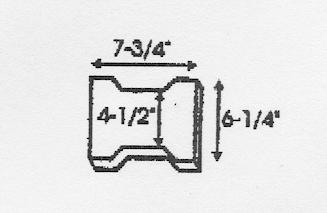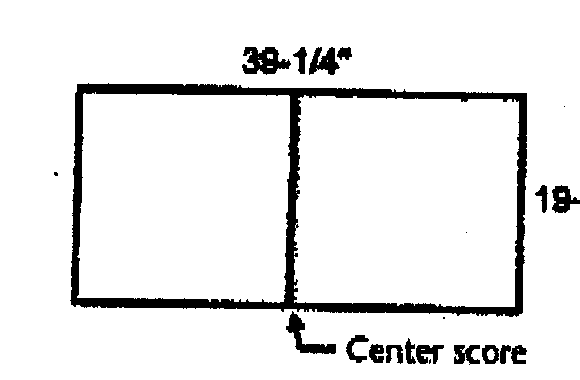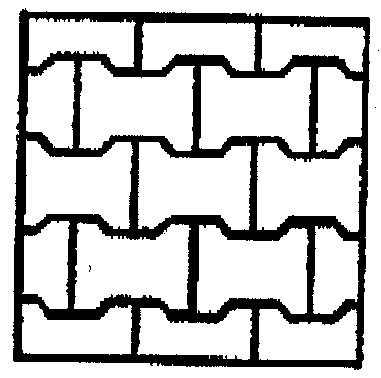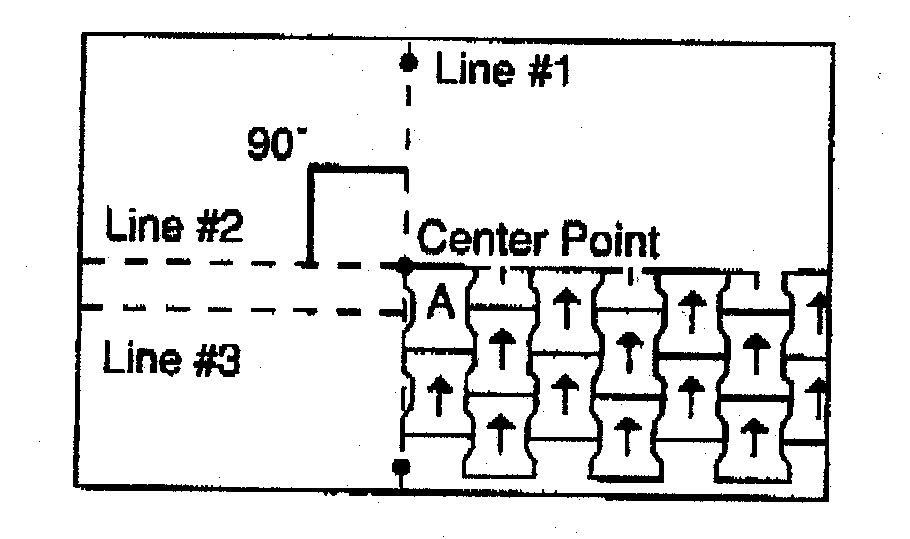| New
Again Rubber Paver Installation Guide |
|
| |
| NOTE:
All New Again Rubber Paver products are to be installed over a solid substrate. |
| |
| Split
Pavers (7/8" thick) must always be adhered to the substrate. |
| |
|  |
| |
| Full
Pavers (1-3/4" thick) may be adhered or loose-laid. If loose-laid,
pavers must be installed against a perimeter border system. Click HERE
for details of Loose Laid Installation. |
 |
 |
| Rectangular
(Scored) Paver Tile |
Square
(Scored) Paver Tile |
|
| |
| A.
INDOOR INSTALLATION |
| 1.
The material and adhesive must be climatized at room temperature for a minimum
of 24 hours before starting installation. |
| |
| 2.
Layout molded pavers or tiles before adhering to minimize cutting and waste. |
| |
3.
Always begin installation with chalk lines that are perfectly square in
the room. It
is best to begin laying tiles away from the walls. |
| |
| 4.
After all above procedures are performed, begin application of recommended
one-component polyurethane adhesive to the substrate using a 1/16"square
notched trowel. Monitor the tooth size of the trowel blade frequently, and
use a new blade with each new pail of adhesive. |
| |
| 5.
Apply adhesive evenly at a rate of approximately 75 square feet per gallon
over smooth concrete. Various substrates may effect this coverage rate.
Do not allow adhesive to cure on your hands or the flooring. Wipe off excess
adhesive with a rag dampened with mineral spirits! Cured adhesive is very
difficult to remove from hands. The wearing of gloves when using the
adhesive is strongly suggested. |
| |
6.
Place the first tile into the wet adhesive making sure that the edges are
precisely
placed along chalk lines and where they intersect. Press firmly on the flooring
to
remove any curls or entrapped air. |
| |
| B.
LAYING TILES |
| |
| 1.
Pavers: Interlock and shift whole pavers from left to right along chalk
line #1 up to the wall on the opposite side of chalk line #2. The last paver
will likely have to be cut to fit against the wall. See diagram below. |
| |
|
 |
| |
| 2.
Tiles and Paver tiles: Place the first tile A into the wet adhesive
making sure that the edges are precisely placed along the chalk lines and
where they intersect. Press firmly on the tiles to remove any curls or entrapped
air. |
| |
| 3.
Continue this process with each row until you reach the wall across from
chalk line #1. |
| |
| 4.
Go back and fill in gaps between the two original chalk lines and the wall
on those two sides. |
| |
| 5.
Immediately roll the floor with a 100 Ib. roller to ensure proper transfer
of adhesive. Overlap each pass of the roller by 50% of the previous pass
to ensure that the floor is properly rolled. Roll the width first then the
length. Re-roll after 30-45 minutes. |
| |
| 6.
Keep foot traffic off the floor for a minimum of 24 hours. Foot traffic
and rolling loads can cause permanent indentations in the uncured adhesive
and cause tiles to shift. |
| |
| 7.
Allow the adhesive to cure for a minimum of 12 hours before applying any
sealer to the floor. |
| |
| C.
OUTDOOR INSTALLATION |
| |
1
.Glued down installation on concrete, asphalt and crushed stone. Base materials
for New Again Pavers are fully cured concrete or asphalt. Both are ideal
for load bearing areas with heavy traffic or
moving vehicles |
| |
| 2.
Make sure to allow for a 1.5% slope or fall for moisture movement to drainage
pit. |
| |
3.
Bituminous concrete mixture requirements for asphalt top layer specifications
are outlined below:
| Sieve
Size |
Opening |
Millimeters |
%
Passing |
| 3/8" |
.375 |
9.53 |
100 |
| #4 |
.187 |
4.75 |
80 |
| #8 |
.0937 |
2.36 |
54 |
| #16 |
.0469 |
1.18 |
32 |
| #30 |
.0234 |
0.60 |
18 |
| #50 |
.0117 |
0.300 |
12 |
| #100 |
.0059 |
0.150 |
9 |
| #200 |
.0029 |
0.075 |
6 |
|
| |
| Note:
A filter fabric is necessary for crushed stone bases. Tiles are adhered
to the filter fabric. This tilt filter fabric system will allow moisture
to penetrate e between surface joints and to evaporate in the base. Some
bases will require a plastic perforated drain to remove possible moist re
build-up. |
| |
| 4.
Lay out molded pavers or tiles before adhering to minimize cutting and waste. |
| |
| 5.
Always begin installation with chalk lines that are perfectly square. It
is best to begin laying prod ct away from the walls. |
| |
6.
After all above procedures have been performed, begin application of recommended
one-component
polyurethane adhesive. Apply adhesive to the substrate using a 1/8"
square notched trowel. Monitor the tooth size of the trowel blade frequently
and use a new blade as needed to ensure the proper amount of adhesive is
applied. |
| |
7.
Apply adhesive evenly at a rate of 60 square feet per gallon over smooth
concrete. Various
substrates may effect this coverage rate. Do not allow adhesive to cure
on your hands or the flooring. Wipe off excess adhesive with a rag dampened
with mineral spirits! Cured adhesive is very difficult to
remove from hands. The wearing of gloves when using the adhesive is strongly
suggested. |
| |
| 8.
Place the molded pavers or tiles into the wet adhesive making sure that
the edges are precisely. placed along chalk lines where they intersect.
Press firmly on the flooring to remove any curls or entrapped air. |
| |
| 9.
LAYING TILES |
| |
| a.
Pavers: Interlock and shift whole pavers from left to right along chalk
line #1 up to the perimeter border on the opposite side of chalk lint! #2.
The last paver will likely have to be cut to fit against the perimeter border.
See diagram. |
| |
| b.
Tiles & Paver tiles: Place the first tile A into the wet adhesive
making sure that the edges are precisely placed along the chalk lines and
where they intersect. Press firmly on the tiles to remove any curls or entrapped
air. |
| |
| 10.
Continue this process with each row until you reach the perimeter border
across from chalk line #1. |
| |
| 1.
Go back and fill in gaps between the two original chalk lines and the wall
on those two sides. |
| |
12.
Roll a 100 Ib roller over the floor within 45 minutes to ensure proper transfer
of adhesive. Overlap each pass of the roller by 50% of the previous pass
to ensure that the floor is properly rolled. Re-roll
after 30-45 minutes. |
| |
| 13.
Keep foot traffic off the floor for a minimum of 24 hours. Foot traffic
and rolling loads can cause permanent indentations in the uncured adhesive
and cause tiles to shift. |
| |
|
D. LOOSE-LAID INSTALLATION: (FULL PAVERS ONLY) |
| |
| 1.
BASE REQUIREMENTS |
| |
| a.
Base must contain sand/crushed stone with perimeter border system. |
| |
| b.
Pavers must be installed butting up against perimeter border system. |
| |
| 2.
CRUSHED STONE SPECIFICATIONS |
| |
| a.
95% standard proctor compaction (as per ASTM D1557) is critical. |
| |
| b.
Stone for the base must be crushed so it compacts to the above standard
and should be a homogeneous mix of the following sizes: |
| Sieve
Size |
%
Passing by Weight |
| 1" |
90
to 100 |
| 5/8" |
50
to 80 |
| 1/4" |
30
to 50 |
| #4 |
15
to 35 |
| #8 |
10
to 30 |
| #30 |
3
to 5 |
| #200 |
0
to 3 |
|
| |
| c.
Minimum depth of crushed stone base should be 4". |
| |
| d.
Base can be flat or sloped 2%. |
| |
| 3.
PROCEDURE |
| |
| a.
Excavate soil approximately 12". |
| |
| b.
Replace soil with approximately 9" of compacted crushed stone and approximately
1" of damp leveling sand. |
| |
| c.
Install perimeter border system. |
| |
| d.
Lay pavers in desired pattern. |
| |




